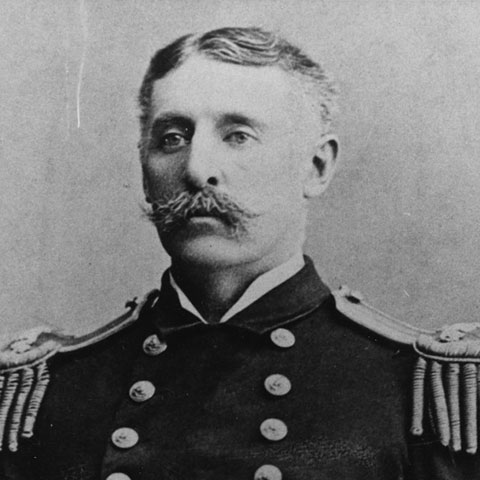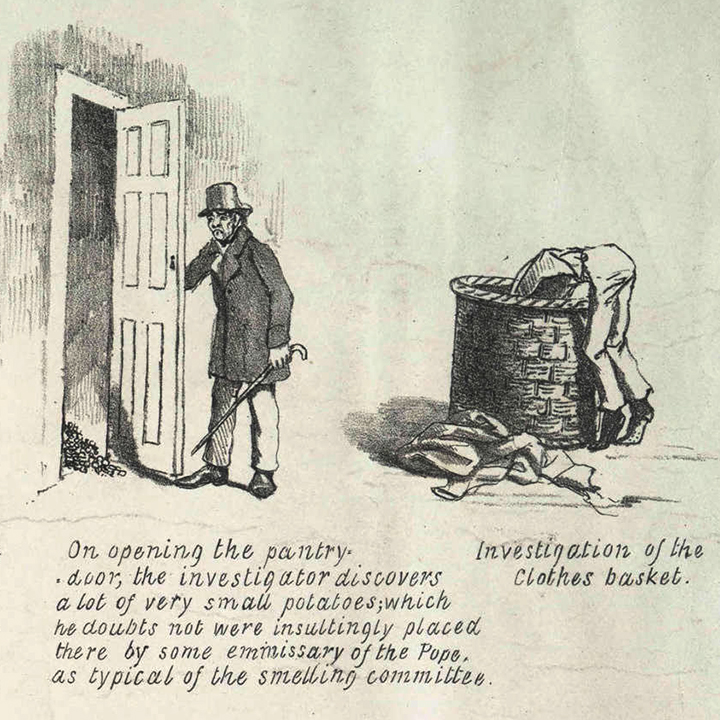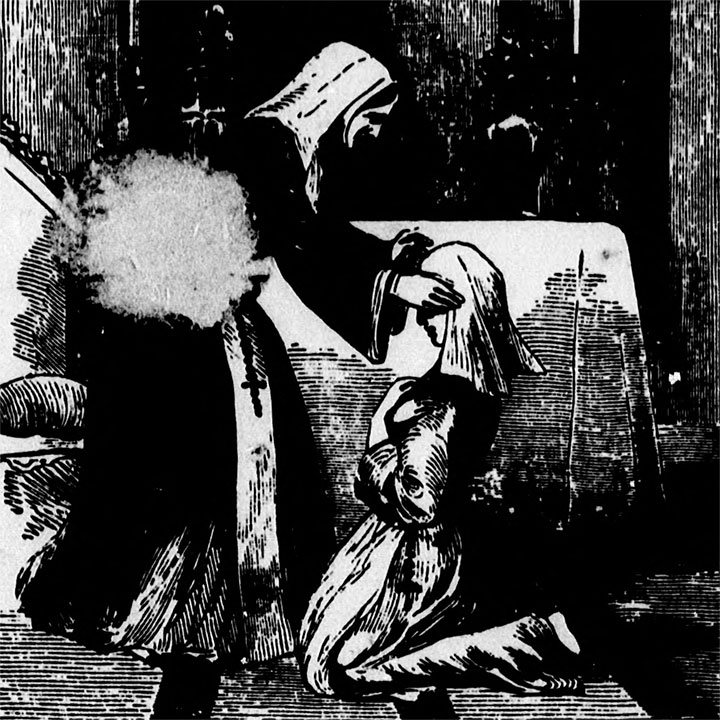
He Fired When Ready
the Spanish-American war's forgotten hero
When I was a child, we took a family trip to the Independence Seaport Museum in Philadelphia. One of the featured attractions there is the USS Olympia, once the pride of the U.S. fleet. Bolted to the deck by the wheelhouse are two brass footprints engraved with the following text:
From this spot Commodore Dewey directed the Asiatic Squadron to victory in the Spanish-American War, launching the United States onto the world stage. ‘You may fire when you are ready, Gridley.’ May 1, 1898, Manila Bay, Luzon, Philippines.
Those are famous words, some of the most famous in naval history. Right up there with “Don’t give up the ship!” and “Damn the torpedoes, full speed ahead!” But who are they addressed to?
Who is Gridley?
Civil War Service
In 1860, Charles Vernon Gridley of Hillsdale, Michigan was sponsored for the U.S. Naval Academy by his congressman, Henry Waldron. Young Gridley achieved no particular distinction at the academy; he was consistently in the bottom half of his class. But he was well-regarded and popular, and somehow picked up the nickname “Steve.”
Upon graduation in 1864, Ensign Gridley was assigned to the USS Oneida under Commander J.R.M. Mullaney. The Oneida was then part of Admiral David Farragut’s blockading squadron in the Gulf of Mexico. When Gridley arrived, the Union navy’s primary goal was to take the city of Mobile, Alabama, cutting off Confederate access to the Gulf of Mexico. That’s how Gridley saw his first action in the Battle of Mobile Bay on August 5, 1864.
Before the Union fleet could engage the Confederate navy in the bay, it first had to maneuver through the main channel, avoiding Confederate mines and a near-constant bombardment from the batteries at Fort Morgan. Farragut’s battle plan was twofold: first, he would send in a column of ironclads to soak up enemy fire. Behind them the wooden vessels would creep along, lashed together in a sort of naval buddy system.
The Oneida was one of the last ships to pass through the channel. Gridley was stationed in the ship’s forecastle in an exposed position, so he could navigate the ship through the thick smoke and spot any mines that hadn’t been set off by the rest of the fleet. During the passage the Oneida came under heavy fire from Fort Morgan and the guns of the CSS Tennessee. The ship took serious damage, but was pulled to safety by the USS Galena. Gridley’s commanding officer later declared his conduct to be “above all praise,” which was a feather in the young officer’s cap.
Mobile Bay was the last major naval operation in the Gulf theater. After the South surrendered, Gridley showed some kindness and gallantry to his defeated foes, when he went over and above the call of duty to assure safe passage to a group of ex-Confederates exiled to Mexico.
Peacetime Service
The post-Civil War period was rough for the U.S. Navy. Wartime promotions had created more officers than it realistically needed, and decades of peace meant those officers had few opportunities to distinguish themselves. It was not unheard of for junior officers to spend a decade or more stuck at the rank of ensign. The ambitious were left with few options; they either had to wait for their superiors to make room when they retired or died, or start playing the games of politics and patronage. Fortunately for Gridley he managed to finagle a promotion to lieutenant commander shortly after the war, giving him a comfortable position from which he could play the waiting game.
After five years sailing the South Seas on the USS Brooklyn and the USS Kearsage he was transferred to the USS Michigan in 1871. The Michigan was ostensibly meant to patrol the Great Lakes and keep our northern border safe from perfidious Canadians, but the harsh winter kept it anchored in Erie, Pennsylvania almost half of the year. During that first winter Gridley met and married Harriet Vincent, the eldest daughter of prominent local judge John Pericles Vincent. Steve and Hattie were much in love – and his new father-in-law had a position of influence which could not only help Gridley’s career but also secure patronage jobs for his mother and brother.
After two years on the Michigan, Gridley returned to the South Atlantic aboard the USS Monongahela, then did stints as an instructor at the Naval Academy and as the executive officer of the USS Trenton in Europe. He also served as the Inspector of the Tenth Lighthouse District for four years, a post secured for him by his father-in-law to keep which would keep him close to his wife and family, which had grown to include three children, Ruth, Katherine, and John.
In 1892 Gridley received his first command, the USS Marion. His two-year Asian tour with the Marion would have been uneventful if it weren’t for an unexpected typhoon that had to be weathered in its final months. Then it was back to Erie for another three-year tour of duty as Lighthouse Inspector.
In 1897, Gridley was finally promoted to the rank of captain and given command of the USS Olympia, the flagship of the Asiatic Squadron. The Olympia was one of the most modern ships in the navy at the time, and considered to be a highly desirable posting. Gridley proved to be a popular commander, somehow able to run a tight ship without being a strict disciplinarian.
Spanish-American War Service
And then, on February 15, 1898 the USS Maine exploded while anchored at Havana, Cuba. The United States and Spain had been at each other’s throats for months. The American public was disdainful of the heavy-handed tactics the Spanish had been using to put down popular uprisings in the Caribbean, while the American government and business interests were trying to find ways to snatch Spain’s colonial possessions for their own. The Spanish were just tired of American hypocrisy and moralizing. Once the Maine exploded, it was war.
The commander of the Asiatic Squadron, Commodore George Dewey, had been preparing for war for months. He knew the Spanish hold on their Pacific possessions was tenuous at best, and if he moved quickly he could strike the first blow and severely weaken Spanish resolve. When war was declared, he moved decisively to crush the Spanish fleet operating out of Manila in the Philippines.
He almost did it without Gridley. For several months Steve had been severely ill, suffering from dysentery and an unspecified liver condition. Some days he could barely leave his bed. But if the fleet was going into battle, Gridley was determined to be with it. It had been thirty three years since his last battle, and he was getting old. This could have been his last chance for glory and promotion. He pleaded with Dewey to let him stay on, and the commodore relented.
Under cover of darkness on April 30, Dewey sailed the entire squadron past the batteries on Corregidor and into Manila Bay. The Spanish were not expecting the Americans to make a move at night so their ships were anchored at Cavite, a small peninsula which provided some protection from the weather and tides. When the sun rose on May 1 they were surprised to find themselves bottled up by the entire Asiatic Squadron. There was no avenue of retreat, and they were too far away from the city for the shore batteries to come to their aid.
At 5:41 AM, Dewey turned to his captain and gave a brief, informal order: “You may fire when you are ready, Gridley.” Fire he did.
The Battle of Manila Bay was a one-sided slaughter. Outgunned and under-armored, the only real hope for the Spanish fleet was to ram the American vessels, but concentrated fire tactics made that impossible. The only real hiccup in the American battle plan came at 7:45 AM, when a garbled message from the quartermaster forced Gridley to message Dewey that only fifteen rounds of ammunition remained for each gun. The Squadron retreated to the middle of the bay and had an impromptu breakfast for the enlisted men while ammunition was counted. It was eventually determined that the report was backwards; fifteen rounds of ammunition had been expended per gun. Breakfast was cut short and the action resumed. After seven hours of battle, the Spanish finally surrendered at 12:40 PM. They really didn’t have a choice — their fleet had been annihilated.
The Asiatic Squadron had suffered few casualties – but Gridley was one of them. The heat and poor ventilation in the ship’s conning tower exacerbated his existing medical condition. At one point in the battle he hit his side on the edge of the chart table, which caused him excruciating pain. After the battle he had to be carried away from his post. As the month wore on, it became clear that his condition was deteriorating rapidly, and Dewey had no choice but to relieve him of command. On May 25 he was sent home aboard the USS Zafiro to receive medical treatment.
Two days later he was transferred from the Zafiro to a commercial steamer, the Occidental & Oriental Steamship Company’s Coptic, which was bound for Japan. On June 4, when the Coptic reached Nagasaki, Gridley discovered that he and Dewey were the men of the hour. He gave a British newspaper reporter a short interview tinged with a little bitterness. He did not see much of a future for the US in the Philippines, seeing the islands as a backwater suitable only as a rest stop for fleets crossing the Pacific. Still, he had no regrets, saying “The battle of Manila killed me, but I would do it again if necessary.”
Those were Gridley’s last words on the public record. He died on June 5 while the Coptic was anchored in Kobe. His body was cremated in Yokohama and the ashes were sent on to his widow in Erie, where they were interred at Lakeside Cemetery with great fanfare. The Navy later placed four guns captured from the Spanish arsenal at Cavite by his graveside.
Fifteen years later, the people of Erie celebrated Gridley once again by naming a municipal park after him. In the center of Gridley Park is a simple Ionic column standing tall. At its base are two plaques recounting the details of Gridley’s service and death, made from metal recovered from the wreckage of the USS Maine.
Legacy
So, what is the appeal of Gridley? He was well-liked by all, but not particularly regarded for his gallantry, military acumen, or initiative. He gave years of service to his country, but achieved little distinction. His only real claim to fame was that he was standing next to the man of the hour when that man’s moment finally came. Even the Battle of Manila Bay was largely a meaningless victory – the Spanish fleet never really had a chance, and the US lacked the strength to take and hold the Philippines afterwards. In fact, they spent most of the next three months trying to stop the Germans from taking them.
Yet Dewey’s famous order has secured Gridley’s place in the history books for eternity. In addition to the park in Erie, he’s also lent his name to four ships in the US Navy, a type of destroyer, and a National Guard training camp in Pennsylvania. His alma mater, Hillsdale College, added a seashell to their coat of arms to honor his service. For someone who did relatively little, he made the most out of what little he actually did. (Or he would have, had he lived.)
But maybe that’s part of his mystique. He’s a well-regarded heroic figure who died at the peak of his fame. He never had the chance to disappoint the public or to be revealed as a lucky mediocrity like Dewey. He’s too big to be built up, but too small to bother tearing down.
In hindsight, he’s a man who seems to have been destined to be a footnote to history.
Connections
Gridley’s victory in the Battle of Manila Bay was immortalized in music by John S. Duss, the last Trustee of Pittsburgh’s Harmony Society (“No Man Take Thy Crown”). It was also commemorated by San Francisco’s Dewey Monument, sculpted by Robert Ingersoll Aitken (“The Brouhaha”).
Gridley is buried in Erie, PA. Also buried in Erie is “Mad” Anthony Wayne, hero of the Northwest Indian War (“He Whooped to See Them Burn”).
After the Spanish-American War, the Germans purchased whatever Pacific holdings Spain hadn’t ceded to the Americans, including the island of Yap (“Cold Hard Cash”).
Supplemental Material
References
- O’Toole, G.J.A. The Spanish War: An American Epic 1898. New York: Norton, 1984.
- Sauers, Richard A. Pennsylvania in the Spanish American War. Harrisburg: Capitol Preservation Committee, 1998.
- Schoenfeld, Maxwell P. Charles Vernon Gridley: A Naval Career. Erie: Erie County Historical Society, 1983.
- “Charles Vernon Gridley.” Wikipedia. https://en.wikipedia.org/wiki/Charles_Vernon_Gridley. Accessed 3/11/2019.
- “USS Olympia.” Naval History and Heritage Command. https://www.history.navy.mil/research/histories/ship-histories/danfs/o/olympia.html. Accessed 3/22/2019.
- “Capt. Charles V. ‘Steve’ Gridley.” The Spanish-American War Centennial Website. http://www.spanamwar.com/Gridley.htm. Accessed 04/24/2019.
Links
Categories
Tags
Published
First Published:
Last Edited:


